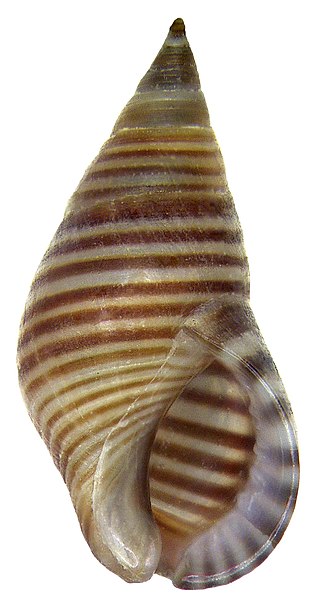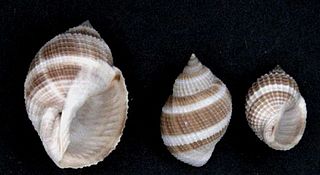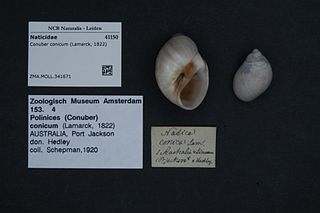
Dicathais is a genus of predatory sea snails, marine gastropod molluscs in the family Muricidae, the rock snails. This genus is monotypic; the only species in it is Dicathais orbita, common name the white rock shell or cart-rut shell, found round the coasts of Australia and New Zealand.

Hipponix, common name hoof snails or hoof shells, is a genus of small sea snails with limpet-like shells, marine gastropod molluscs in the family Hipponicidae, the hoof snails. Many of the species in this genus have white shells.

Planaxidae, commonly called planaxids or clusterwinks, are a taxonomic family of small and minute sea snails, pantropical marine gastropod molluscs in the superfamily Cerithoidea. They live on rocky shores in the littoral zone of the tropics and subtropics.

Gyroscala lamellosa, common name : the lamellose wentletrap, is a species of medium-sized predatory sea snail, a marine gastropod mollusc in the family Epitoniidae, the wentletraps.

Austrocochlea is a genus of medium-sized sea snails, marine gastropod molluscs in the family Trochidae, the top snails, also known as top shells.

Merica elegans, common name the elegant nutmeg, is a species of sea snail, a marine gastropod mollusk in the family Cancellariidae, the nutmeg snails.

Pardalinops testudinaria, common name : the tortoise dove shell, is a species of sea snail, a marine gastropod mollusk in the family Columbellidae, the dove snails.

The mangrove murex is a species of sea snail, a marine gastropod mollusk in the family Muricidae, the murex snails or rock snails.
Poropteron uncinarius is a species of sea snail, a marine gastropod mollusk in the family Muricidae, the murex snails or rock snails.

Harpa amouretta, common name the lesser harp, is a species of sea snail, a marine gastropod mollusk in the family Harpidae, the harp snails.

Harpa articularis, common name the articulate harp shell, is a species of sea snail, a marine gastropod mollusk in the family Harpidae, the harp snails.

Trochus maculatus, common name the maculated top shell, is a species of sea snail, a marine gastropod mollusk in the family Trochidae, the top snails.

Hinea fasciata is a species of sea snail, a marine gastropod mollusk in the family Planaxidae

Angiola is a genus of sea snails, marine gastropod mollusks in the family Planaxidae.

Planaxis is a genus of small sea snails, marine gastropod mollusks in the family Planaxidae.

Ovula costellata is a species of sea snail, a marine gastropod mollusk in the family Ovulidae, the ovulids, cowry allies or false cowries.

Nassarius pyrrhus, common name the red-banded nassa, is a species of sea snail, a marine gastropod mollusc in the family Nassariidae, the nassa mud snails or dog whelks.
Hinea longispira is a species of sea snail, a marine gastropod mollusk in the family Planaxidae.
Thylacodes sipho, the common worm-shell, is a species of sea snail, a worm shell, a marine gastropod mollusc in the family Vermetidae, the worm snails.

Conuber conicum, the conical moon snail, is a species of predatory sea snail, in the family Naticidae, the moon snails. It was first described in 1822 as Natica conica by Jean-Baptiste Lamarck.















